Joanna Gosling 4pm - 7pm

Now Playing
The Magic Flute - Overture Wolfgang Amadeus Mozart Download 'The Magic Flute - Overture' on iTunes
This is what the spacecraft Voyager 1 sounds like in musical form… and it’s really quite beautiful
24 November 2017, 15:43 | Updated: 24 November 2017, 15:55
By Lizzie Davis

Dr Domenico Vicinanza used data beamed back from Voyager 1 to create a three-minute piece for strings and woodwind.
Dr Vicinanza is a particle physicist and senior lecturer at Anglia Ruskin University in Cambridge. But he’s also a composer and orchestrator.
“I spent my entire research career as a scientist keeping thinking as a musician,” said Dr Vicinanza, “looking for harmonies, choosing music as a main language to communicate to the general public.
This year marks the 40th birthday of Voyager 1 and to mark the occasion Dr Vicinanza decided to write a piece of music using data sent back by the spacecraft. The piece received its world premiere earlier this month at the SC17 Supercomputing Conference in Denver.
Dr Vicinanza created music using data captured by Voyager 1’s Low-Energy Charged Particle (LECP) instrument – a special telescope that identifies protons, alpha particles and heavier nuclei in space.

“Our sonification is based on the measurements coming from the LECP, mapping the number of particles that reached the detector to sound. The higher the count, the higher the pitch. Every number from the detector becomes then a music note, creating a melody that follows the entire journey of the spacecraft.”
The result is a piece that charts the spacecraft’s journey through space towards Jupiter, Saturn before finally exiting the solar system in August 2012.
Here’s Dr Vicinanza’s detailed breakdown of the piece:
“The main melody line comes from the sonification of the cosmic ray count from the LECP and it is played by the second violins for data collected from 1977 to 2012 – the year when Voyager 1 left the solar system – then by flute, piccolo and glockenspiel.
“Piano and French horns double the violins during the Jupiter and Saturn encounter, highlighting the rising and falling of the cosmic ray count entering and exiting the atmosphere of the giant planets.
“The transition from the heliosphere to the interstellar space is accompanied in changes in the orchestration and in the harmony. The accompaniment of lower strings (cellos and violas) and the woodwind chords that were framing the melody throughout its journey through the solar system leaves the place to a more ethereal harmony played by harp and celesta when Voyager is in the interstellar space.
The transition is also marked by a change in the music key (tonality), from C major to E flat major.
Finally, the spacing between the notes, the music intervals, the orchestration writing change as well, following the dramatic change in the density of charged particles. The entire piece is breathing and pulsating with the spacecraft, an orchestra score that is more than just inspired by one of the most successful space mission, it becomes part of it.”
Latest on Classic FM
Operatic mezzo stuns with impromptu bizet ‘habanera’ in busy london restaurant, in historic first, a lord of the rings opera has been approved by the tolkien estate, new ‘amadeus’ tv series reveals mozart and salieri actors, musicians break guinness world record with 26-hour concert of music by women composers, why are orchestras arranged the way they are.
Discover Music
Russian republic announces ban on music that is too slow or too fast
Pavarotti kept a secret pasta stash at the met opera for snacking between arias.
Luciano Pavarotti
15 ultimate studying and revision tips including classical music
Classical music for studying: the 14 greatest pieces for brain power, who is sheku kanneh-mason star british cellist’s age, family, albums and more revealed.
Sheku Kanneh-Mason
Best classical music
See more Best classical music
The 15 most famous tunes in classical music
The 15 greatest symphonies of all time, the 4 eras of classical music: a quick guide, the 25 greatest conductors of all time, 30 of the greatest classical music composers of all time, the 25 best pianists of all time, classic fm live playlists.
See more Classic FM Live Playlists
Classic FM Hall of Fame
Classic FM Relax
Classic fm revision, classic fm pet classics, classic fm’s romantic classics, classic fm movie music hall of fame, latest news.
See more Latest news
What does ‘music’ mean, and what is the origin of music?
Chopin and beethoven’s music helps students pass exams, study finds, yuja wang wore a heart rate monitor in rachmaninov marathon, with astonishing results, star tenor freddie de tommaso presents new classic fm series celebrating classical music of italy, how bach inspired beyoncé – all the classical music references in ‘cowboy carter’, rachmaninov’s piano concerto no.2 crowned nation’s favourite for second year running, latest videos.
See more Latest videos
When Pavarotti and Tracy Chapman stunned the world in a soulful operatic duet
22 days ago
Pianist plays 7 levels of ‘Twinkle Twinkle Little Star’ with increasing virtuosity
27 days ago
Andrea Bocelli sings moving ‘Time to Say Goodbye’ duet with son Matteo at Oscars ceremony
1 month ago
Andrea Bocelli
Amy Beach’s stunning Romance, played by a rising star violinist for International Women’s Day
Classical musicians got stuck in traffic with their instruments, and there was only one thing to do, footage emerges of boy soprano recording breathtaking vocals for ‘lord of the rings’ score.
- GTA 5 Cheats
- What is Discord?
- Find a Lost Phone
- Upcoming Movies
- Nintendo Switch 2
- Best YouTube TV Alternatives
- How to Recall an Email in Outlook
- Emerging Tech
Here’s how NASA transformed Voyager 1 data into a beautiful (and super geeky) song
For years, scientists have tracked charged particles as they zoom through the cosmos, using deep space probes to measure the particles’ paths and mapping algorithms to translate the data into musical scores. Now a team of space-music buffs have premiered a new composition to celebrate one of NASA’s most ambitious missions using measurements from mankind’s most distance creation — the Voyager 1 spacecraft.
The composition was created by Domenico Vicinanza, a researcher at GÉANT, and Genevieve Williams of the University of Exeter. Together they turned forty-years of cosmic data into a three-minute score, featuring instruments like a violin, flute, French horn, and glockenspiel. It was recently premiered at the SC17 Supercomputing Conference in Denver, Colorado.
“As scientists we are intrigued and fascinated by the universe around us,” Williams told Digital Trends. “And we have a passion for space and space exploration in particular.”
“Space data arrives at NASA’s Space Physics Data Facility as numbers, not orchestral notes.”
Launched by NASA a little over four decades ago, Voyager 1 now throttles away from Earth at 17 m/s, carrying equipment that still manages to relay information to Earth despite being past its prime. After completing its primary mission in in 1980, the spacecraft embarked on an extended journey through the Solar System that would see it enter interstellar space and become to first probe to beam back data on from the medium beyond.
But this information arrives at NASA’s Space Physics Data Facility as numbers, not orchestral notes. To turn the data to music, the researchers use a process called data sonification.
“Sonification is the translation of information like numbers and scientific measurements into audible signals, like sounds, music notes, or melodies,” Williams said. “It is based on mapping certain characteristics of the initial information to audible parameters, for example the larger the number, the higher the pitch of the note.”
In the case of the Voyager 1 data, Vicinanza and Williams used an algorithm to map the time between measurements made by the spacecraft’s Low Energy Charged Particle ( LECP ) detector to intervals between notes on a scale. Increasing data became increasing pitch. Decreasing data became decreasing pitch.
“In this way the music inherited the structural characteristics of the data, its regularities, its character, its behavior,” Vicinanza said.
The idea that space holds music dates back at least to medieval Europe, and was explored by Johannes Kepler in Harmonices Mundi , in which the astronomer mapped the velocity of planets to pitches in order to express their elliptical orbits.
“What we did with Voyager 1 data is really similar to what Kepler did,” Vicinanza said. “Our sonification is based on the measurements coming from the LECP, mapping the number of particles that reached the detector to sound. The higher the count, the higher the pitch. Every number from the detector becomes then a music note, creating a melody that follows the entire journey of the spacecraft.”
As a result, the score depicts Voyager 1’s journey, including its dramatic approaches to Jupiter and Saturn, and entrance into interstellar space. Like Kepler, Vicinanza and Williams hope their composition helps colleagues — and laypeople – appreciate and better understand the workings of the cosmos.
This isn’t the first time Vicinanza has turned science data into sound. In 2012, he transformed data about the Higgs Boson particle discovery into a musical motif, and a few years ago he created a separate composition from Voyager 1’s 37 years of data.
But the spacecraft won’t be able to beam back information forever. At some 140 astronomical units from the Sun, Voyager 1 can no longer rely on solar power, and its generators are only expected to last until about 2025. At that point, the probe will truly go silent.
Editors' Recommendations
- NASA to announce Mars 2020 rover name, here’s how to watch

Let there be no doubt: CES isn’t just alive in 2023; it’s thriving. Take one glance at the taxi gridlock outside the Las Vegas Convention Center and it’s evident that two quiet COVID years didn’t kill the world’s desire for an overcrowded in-person tech extravaganza -- they just built up a ravenous demand.
From VR to AI, eVTOLs and QD-OLED, the acronyms were flying and fresh technologies populated every corner of the show floor, and even the parking lot. So naturally, we poked, prodded, and tried on everything we could. They weren’t all revolutionary. But they didn’t have to be. We’ve watched enough waves of “game-changing” technologies that never quite arrive to know that sometimes it’s the little tweaks that really count.
CES is more than just a neon-drenched show-and-tell session for the world’s biggest tech manufacturers. More and more, it’s also a place where companies showcase innovations that could truly make the world a better place — and at CES 2023, this type of tech was on full display. We saw everything from accessibility-minded PS5 controllers to pedal-powered smart desks. But of all the amazing innovations on display this year, these three impressed us the most:
Samsung's Relumino Mode Across the globe, roughly 300 million people suffer from moderate to severe vision loss, and generally speaking, most TVs don’t take that into account. So in an effort to make television more accessible and enjoyable for those millions of people suffering from impaired vision, Samsung is adding a new picture mode to many of its new TVs. [CES 2023] Relumino Mode: Innovation for every need | Samsung Relumino Mode, as it’s called, works by adding a bunch of different visual filters to the picture simultaneously. Outlines of people and objects on screen are highlighted, the contrast and brightness of the overall picture are cranked up, and extra sharpness is applied to everything. The resulting video would likely look strange to people with normal vision, but for folks with low vision, it should look clearer and closer to "normal" than it otherwise would. Excitingly, since Relumino Mode is ultimately just a clever software trick, this technology could theoretically be pushed out via a software update and installed on millions of existing Samsung TVs -- not just new and recently purchased ones.
- Entertainment
These days, it seems like there's nothing AI programs can't do. Thanks to advancements in artificial intelligence, deepfakes have done digital "face-offs" with Hollywood celebrities in films and TV shows, VFX artists can de-age actors almost instantly, and ChatGPT has learned how to write big-budget screenplays in the blink of an eye. Pretty soon, AI will probably decide who wins at the Oscars.
Within the past year, AI has also been used to generate beautiful works of art in seconds, creating a viral new trend and causing a boon for fan artists everywhere. TikTok user @cyborgism recently broke the internet by posting a clip featuring many AI-generated pictures of Breaking Bad. The theme here is that the characters are depicted as anime characters straight out of the 1980s, and the result is concerning to say the least. Depending on your viewpoint, Breaking Bad AI (my unofficial name for it) shows how technology can either threaten the integrity of original works of art or nurture artistic expression. What if AI created Breaking Bad as a 1980s anime? Playing over Metro Boomin's rap remix of the famous "I am the one who knocks" monologue, the video features images of the cast that range from shockingly realistic to full-on exaggerated. The clip currently has over 65,000 likes on TikTok alone, and many other users have shared their thoughts on the art. One user wrote, "Regardless of the repercussions on the entertainment industry, I can't wait for AI to be advanced enough to animate the whole show like this."

NASA and music: Voyager 1 and Voyager 2
Latest posts.

The music of NASA's Voyager Golden Records presented by Royal College of Music student Alec Coles-Aldridge.
On 25 August 2012, the Voyager 1 spacecraft entered interstellar space, the matter that exists between the star systems in a galaxy. This achievement made Voyager 1 the furthest travelling man-made object in history. Close behind is Voyager 2, the only spacecraft to have visited Uranus and Neptune.
Remarkably, travelling on each Voyager spacecraft is, amongst other material, Wolfgang Amadeus Mozart’s (1756-1791) Queen of the Night aria from The Magic Flute and Johann Sebastian Bach’s (1685-1750) Prelude and Fugue No 1 in C major from Book Two of The Well-Tempered Clavier . These pieces of music and a selection of other compositions feature in the Voyager Golden Records – phonograph records attached to the spacecraft – whose purpose, as stated by President Jimmy Carter (b.1924), is ‘if one such civilization intercepts Voyager and can understand these recorded contents, here is our message: this is a present from a small distant world, a token of our sounds, our science, our images, our music, our thoughts, and our feelings.’
Inevitably, any consideration of the Voyager Golden Record’s musical content will open a host of questions. Was the chosen music suitable? Why were those particular pieces selected? What impression would it make on extraterrestrial life? With regards to the only piece of keyboard music present, the choice of Bach’s Prelude and Fugue in C performed by Glenn Gould (1932-1982) is understandable.
The piece is less than five minutes thus saving precious space on the record. The piece demonstrates the piano without any additional noise from an orchestra (as a concerto would) and it demonstrates a work by a composer widely considered to be one of the greatest western composers of all time. The fact that the piece is from The Well-Tempered Clavier is significant, as the choice may have been driven by a desire to represent this monumental series of Preludes and Fugues.
Prelude from Book 2 of The Well-Tempered Clavier performed by Glenn Gould:
Trying to conclude the exact reasoning behind their choice is difficult. However, it does lead you to a more personal question: what would I choose? My answer, Frédéric Chopin’s (1810-1849) Nocturne in B flat minor Op 9 No 1 performed by Vladimir Ashkenazy (b.1937). The opening notes fall like droplets and give way to some of the most beautiful music ever written – that’s in my humble opinion. Ashkenazy fearlessly moves between gently caressing the notes and energetically driving the music forwards.
Nocturne in B flat minor Op 9 No 1 performed by Vladimir Ashkenazy:
However, the most interesting insight into the Golden Records is from Jason Wright, an associate professor of Astronomy and Astrophysics at Pennsylvania State University who wrote an article in August 2017 with the conclusion that the real audience for the records is actually Earth. In order to create the records we had to reflect and consider what we thought was a fitting representation of our species. The music scholars Stephanie Nelson and Larry Polansky captured this truth in their research report regarding the Voyager Records stating ‘by imagining another listening we reflect back upon ourselves and open ourselves to new cultures, music, understandings, other possibilities and different worlds.’
By Alec Coles-Aldridge. Alec is a student at the Royal College of Music studying for a Bachelor of Music Degree.

The most distant human-made object

No spacecraft has gone farther than NASA's Voyager 1. Launched in 1977 to fly by Jupiter and Saturn, Voyager 1 crossed into interstellar space in August 2012 and continues to collect data.
Mission Type
What is Voyager 1?
Voyager 1 has been exploring our solar system for more than 45 years. The probe is now in interstellar space, the region outside the heliopause, or the bubble of energetic particles and magnetic fields from the Sun.
- Voyager 1 was the first spacecraft to cross the heliosphere, the boundary where the influences outside our solar system are stronger than those from our Sun.
- Voyager 1 is the first human-made object to venture into interstellar space.
- Voyager 1 discovered a thin ring around Jupiter and two new Jovian moons: Thebe and Metis.
- At Saturn, Voyager 1 found five new moons and a new ring called the G-ring.
In Depth: Voyager 1
Voyager 1 was launched after Voyager 2, but because of a faster route, it exited the asteroid belt earlier than its twin, having overtaken Voyager 2 on Dec. 15, 1977.
Voyager 1 at Jupiter
Voyager 1 began its Jovian imaging mission in April 1978 at a range of 165 million miles (265 million km) from the planet. Images sent back by January the following year indicated that Jupiter’s atmosphere was more turbulent than during the Pioneer flybys in 1973–1974.
Beginning on January 30, Voyager 1 took a picture every 96 seconds for a span of 100 hours to generate a color timelapse movie to depict 10 rotations of Jupiter. On Feb. 10, 1979, the spacecraft crossed into the Jovian moon system and by early March, it had already discovered a thin (less than 30 kilometers thick) ring circling Jupiter.
Voyager 1’s closest encounter with Jupiter was at 12:05 UT on March 5, 1979 at a range of about 174,000 miles (280,000 km). It encountered several of Jupiter’s Moons, including Amalthea, Io, Europa, Ganymede, and Callisto, returning spectacular photos of their terrain, opening up completely new worlds for planetary scientists.
The most interesting find was on Io, where images showed a bizarre yellow, orange, and brown world with at least eight active volcanoes spewing material into space, making it one of the most (if not the most) geologically active planetary body in the solar system. The presence of active volcanoes suggested that the sulfur and oxygen in Jovian space may be a result of the volcanic plumes from Io which are rich in sulfur dioxide. The spacecraft also discovered two new moons, Thebe and Metis.
Voyager 1 at Saturn
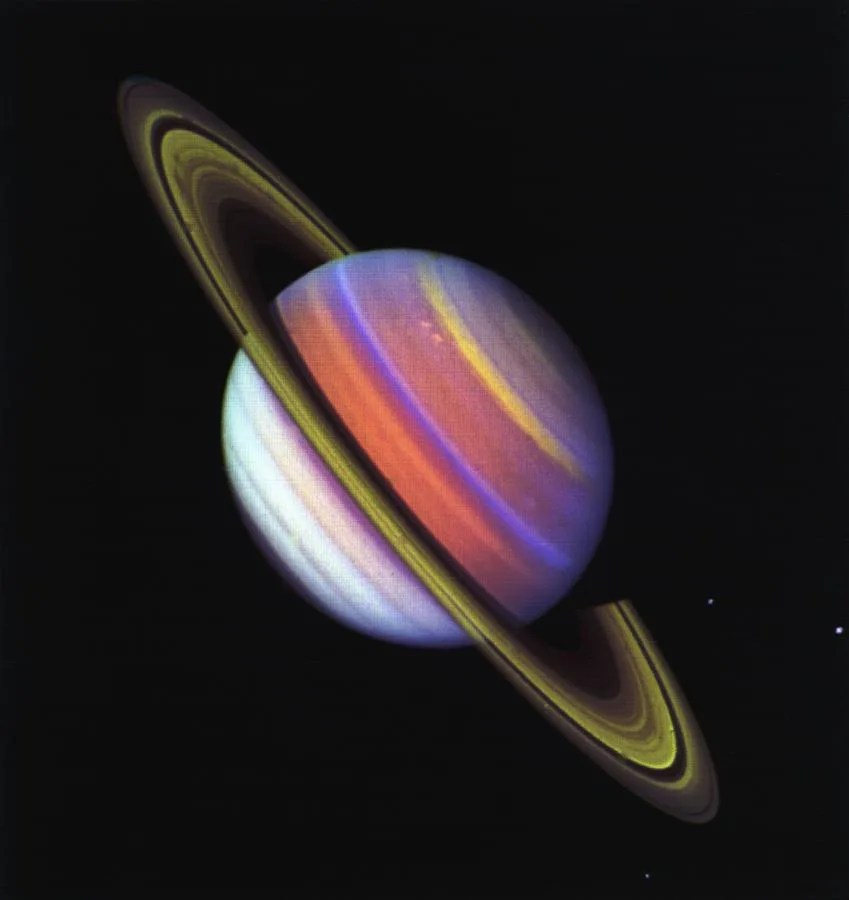
Following the Jupiter encounter, Voyager 1 completed an initial course correction on April 9, 1979 in preparation for its meeting with Saturn. A second correction on Oct. 10, 1979 ensured that the spacecraft would not hit Saturn’s moon Titan.
Its flyby of the Saturn system in November 1979 was as spectacular as its previous encounter. Voyager 1 found five new moons, a ring system consisting of thousands of bands, wedge-shaped transient clouds of tiny particles in the B ring that scientists called “spokes,” a new ring (the “G-ring”), and “shepherding” satellites on either side of the F-ring—satellites that keep the rings well-defined.
During its flyby, the spacecraft photographed Saturn’s moons Titan, Mimas, Enceladus, Tethys, Dione, and Rhea. Based on incoming data, all the moons appeared to be composed largely of water ice. Perhaps the most interesting target was Titan, which Voyager 1 passed at 05:41 UT on November 12 at a range of 2,500 miles (4,000 km). Images showed a thick atmosphere that completely hid the surface. The spacecraft found that the moon’s atmosphere was composed of 90% nitrogen. Pressure ad temperature at the surface was 1.6 atmospheres and 356 °F (–180°C), respectively.
Atmospheric data suggested that Titan might be the first body in the solar system (apart from Earth) where liquid might exist on the surface. In addition, the presence of nitrogen, methane, and more complex hydrocarbons indicated that prebiotic chemical reactions might be possible on Titan.
Voyager 1’s closest approach to Saturn was at 23:46 UT on 12 Nov. 12, 1980 at a range of 78,000 miles(126,000 km).
Voyager 1’s ‘Family Portrait’ Image
Following the encounter with Saturn, Voyager 1 headed on a trajectory escaping the solar system at a speed of about 3.5 AU per year, 35° out of the ecliptic plane to the north, in the general direction of the Sun’s motion relative to nearby stars. Because of the specific requirements for the Titan flyby, the spacecraft was not directed to Uranus and Neptune.
The final images taken by the Voyagers comprised a mosaic of 64 images taken by Voyager 1 on Feb. 14, 1990 at a distance of 40 AU of the Sun and all the planets of the solar system (although Mercury and Mars did not appear, the former because it was too close to the Sun and the latter because Mars was on the same side of the Sun as Voyager 1 so only its dark side faced the cameras).
This was the so-called “pale blue dot” image made famous by Cornell University professor and Voyager science team member Carl Sagan (1934-1996). These were the last of a total of 67,000 images taken by the two spacecraft.
Voyager 1’s Interstellar Mission
All the planetary encounters finally over in 1989, the missions of Voyager 1 and 2 were declared part of the Voyager Interstellar Mission (VIM), which officially began on Jan. 1, 1990.
The goal was to extend NASA’s exploration of the solar system beyond the neighborhood of the outer planets to the outer limits of the Sun’s sphere of influence, and “possibly beyond.” Specific goals include collecting data on the transition between the heliosphere, the region of space dominated by the Sun’s magnetic field and solar field, and the interstellar medium.
On Feb. 17, 1998, Voyager 1 became the most distant human-made object in existence when, at a distance of 69.4 AU from the Sun when it “overtook” Pioneer 10.
On Dec. 16, 2004, Voyager scientists announced that Voyager 1 had reported high values for the intensity for the magnetic field at a distance of 94 AU, indicating that it had reached the termination shock and had now entered the heliosheath.
The spacecraft finally exited the heliosphere and began measuring the interstellar environment on Aug. 25, 2012, the first spacecraft to do so.
On Sept. 5, 2017, NASA marked the 40th anniversary of its launch, as it continues to communicate with NASA’s Deep Space Network and send data back from four still-functioning instruments—the cosmic ray telescope, the low-energy charged particles experiment, the magnetometer, and the plasma waves experiment.
The Golden Record

Each of the Voyagers contain a “message,” prepared by a team headed by Carl Sagan, in the form of a 12-inch (30 cm) diameter gold-plated copper disc for potential extraterrestrials who might find the spacecraft. Like the plaques on Pioneers 10 and 11, the record has inscribed symbols to show the location of Earth relative to several pulsars.
The records also contain instructions to play them using a cartridge and a needle, much like a vinyl record player. The audio on the disc includes greetings in 55 languages, 35 sounds from life on Earth (such as whale songs, laughter, etc.), 90 minutes of generally Western music including everything from Mozart and Bach to Chuck Berry and Blind Willie Johnson. It also includes 115 images of life on Earth and recorded greetings from then U.S. President Jimmy Carter (1924– ) and then-UN Secretary-General Kurt Waldheim (1918–2007).
By January 2024, Voyager 1 was about 136 AU (15 billion miles, or 20 billion kilometers) from Earth, the farthest object created by humans, and moving at a velocity of about 38,000 mph (17.0 kilometers/second) relative to the Sun.

National Space Science Data Center: Voyager 1
A library of technical details and historic perspective.

Beyond Earth: A Chronicle of Deep Space Exploration
A comprehensive history of missions sent to explore beyond Earth.
Discover More Topics From NASA

Our Solar System

March 14, 2024
10 min read
Voyager 1’s Immortal Interstellar Requiem
NASA is reaching across more than 15 billion miles to rescue its malfunctioning Voyager 1 probe—but this hallowed interstellar mission can’t live forever
By Nadia Drake
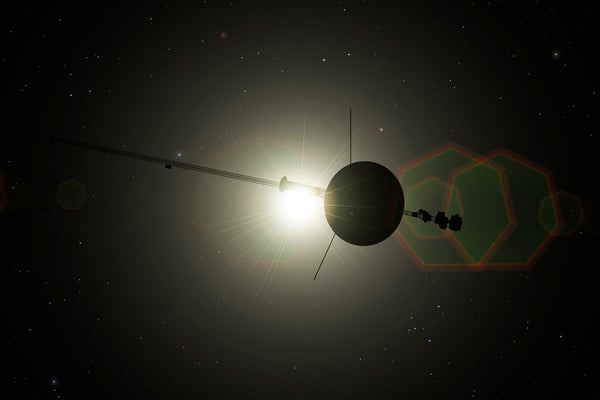
An artist's concept of NASA's Voyager 1, the space agency's venerable and farthest-flung interplanetary probe.
Mark Garlick/Science Photo Library
In the fall of last year, one of NASA’s most venerable spacecraft started beaming home nonsense. Its usual string of 1’s and 0’s—binary code that collectively told of its journey into the unknown—became suddenly unintelligible.
Some 15 billion miles from Earth, beyond the protective bubble blown by the sun and in interstellar space, Voyager 1 was in trouble.
“We’d gone from having a conversation with Voyager, with the 1’s and 0’s containing science data, to just a dial tone,” says Linda Spilker , Voyager project scientist at NASA’s Jet Propulsion Laboratory (JPL).
On supporting science journalism
If you're enjoying this article, consider supporting our award-winning journalism by subscribing . By purchasing a subscription you are helping to ensure the future of impactful stories about the discoveries and ideas shaping our world today.
Spilker joined JPL in 1977, the same year that NASA launched Voyager 1 and its twin, Voyager 2 , on what, in a way, was an endless odyssey: from Earth, to the outer solar system and ultimately to interstellar infinity . Today there are several billion people on Earth who have never taken a breath without the Voyagers in our sky, people who, like me, have only ever existed in a cosmos shared with these talkative twin spacecraft. But like people, spacecraft get old. They break down .
And all good things—and even great ones—must come to an end. After days, and weeks and then months of nothing but indecipherable binary babbling, Voyager 1’s earthbound stewards had to reckon with the idea that maybe, after more than 46 years, its time had at last run out.
The Voyager 1 team at JPL had traced the problem to the spacecraft’s Flight Data System, an onboard computer that parses and parcels engineering and science measurements for subsequent radio transmittal to Earth. One possibility was that a high-energy cosmic particle had struck Voyager 1 and caused a bit flip within the system’s memory — something that has happened more frequently as the craft navigates the hostile wilds of interstellar space. Normally, the team would simply ask the spacecraft for a memory readout, allowing its members to find and reset the errant bit.
“We’ve recovered from bit flips before. The problem this time is we don’t know where the bit flip is because we can’t see what the memory is,” says Suzanne Dodd , Voyager project manager at JPL, who, like Spilker, began her long career with work on the probes. “It’s the most serious issue we’ve had since I’ve been the project manager, and it’s scary because you lose communication with the spacecraft.”
Yesterday, the team announced a significant step in breaking through to Voyager 1. After months of stress and unsuccessful answers they have managed to decode at least a portion of the spacecraft’s gobbledygook, allowing them to (maybe) find a way to see what it has been trying to say.
“It’s an excellent development on Voyager,” says Joe Westlake , director of NASA’s heliophysics division, which oversees the mission.
In the time it will take you to read this story, Voyager 1 will have traversed approximately 10,000 miles of mostly empty space ; in the weeks it took me to report it, the probe traveled some 26 million miles. And since its communication first became garbled last November, the spacecraft has sailed another 10 light-minutes away from home. Voyager 1 and its twin are slipping away from us as surely as the passage of time itself. Sooner or later, these hallowed space-age icons will fall silent, becoming no more than distant memories.
And even among the space community, which of course loves all of its robotic explorers equally, the Voyagers are special. “They are incredibly important and much beloved spacecraft,” says Nicola Fox , NASA’s associate administrator for science. “Voyager 1 is a national treasure, along with Voyager 2 .”
As envisioned, the Voyager mission would exploit a once-in-175-year alignment of Jupiter, Saturn, Uranus and Neptune to slingshot through the solar system’s sparsely charted hinterlands. Legend has it that NASA’s administrator sold the project to President Richard Nixon by noting that the last time the planets were so favorably arranged, Thomas Jefferson was living in the White House. Outfitted with nuclear power sources, the Voyagers were built to last—in utter defiance of the adage that what must go up, must come down. Neither was ever intended to make planetfall again; instead they were bound for the stars. And now, nearly a half-century later, the pair have become the longest-lived and farthest-flung probes ever dispatched by humankind. (Voyager 1 is the front-runner, with its sibling trailing close behind.)
Spilker was straight out of college when she started working on the Voyagers, eager to see the outer solar system through their robotic eyes as they surfed the rare celestial alignment. “I had a telescope in third grade that I used to look at Jupiter and Saturn,” she says. “I wanted to get up really close and get a look at what these planets look like.”
Between 1979 and 1981, Voyager 1 and Voyager 2 zipped by the gas giants , returning stunning images of banded Jupiter and buttery Saturn and their bewildering collection of moons. Voyager 2 went on to scrutinize the ice giants: Uranus in 1986 and Neptune in 1989. These were the first and only times anyone had seen each of these bluish ringed worlds up close.
“They were small little pinpoints of light, and now you’re flying close,” Spilker says. “And you see the cliffs of Miranda”—a bizarre Uranian moon—“and Triton, with active geysers going off.” (Nobody had expected to see an active icy world in orbit around Neptune, and even now Voyager’s 35-year-old image is still the best we have of that strange little moon.)
When the Voyagers left the realm of the known planets, each followed a different path into darkness: Voyager 1 arced up and out of the plane of the solar system, and Voyager 2 looped downward. Spilker also followed her own path: she went to graduate school and earned her doctorate in planetary science using Voyager data—not knowing that several decades later, after leading NASA’s Cassini mission to Saturn, she’d again be part of the mission that started it all.
“The chance came to go back to Voyager,” she says. “And I said, ‘Of course. I’d love to go back.’”
In the interim, as the Voyagers sailed farther from their Earthly harbor, teams shut down many of the onboard instruments, including the cameras. But the pair kept studying the space that they alone were visiting. Their main job was now to characterize the heliosphere—the solar-system-encompassing, cosmic-ray-blocking bubble formed by our sun’s wind and magnetic field. They would document the alien mix of particles and fields that pervade near nothingness. And maybe, if they got lucky, the twins would each escape the protective solar caul entirely to be reborn as true interstellar wanderers.
In 2012 Voyager 1 transcended this boundary , known as the heliopause, where the sun’s influence wanes. Before that scientists could only guess at what lay beyond this barrier and could only model how it shielded Earth from the harshness of the void. Now Voyager 1 could tell us directly about the stuff between the stars. Voyager 2 followed in 2018 , and Fox—then the new chief of NASA’s heliophysics division—was in the midst of the action.
“You’re looking at the cosmic rays going up and the solar wind going down, and it was one of those ‘oh, my god, this is so exciting’ moments,” Fox recalls. “I think of the Voyagers as one mission,” she says. “We’re putting all the data together, but they’re the ones that are out there. They’re the brave spacecraft that have left the protective bubble of the heliosphere and are out exploring interstellar space. It’s hard not to be excited by them.”
This wasn’t the first time Voyager 1 had started speaking an unintelligible language. In 2022, when the probe suffered an earlier bout of garbled telemetry, JPL engineer Bob Rasmussen was shaken out of retirement. The lab wanted to know if Rasmussen, who’d joined the spacecraft’s systems engineering team in 1975, was willing to have a think about the situation.
“I’d been happily retired for a bit more than a year at that point, with plenty else to keep me busy,” Rasmussen says. “But I like solving puzzles, and this was a tough one that I just couldn’t pass up. Cracking it took a few months, but the puzzle stream hasn’t slowed since then.”
Afterward, he stayed on-call. So last November, when Voyager 1 again started transmitting nonsense, Rasmussen was ready for more problem-solving. He was joined by a hand-picked team of specialists, and together they dove into the details for getting the ailing spacecraft back in action.
The problems were at least three layers deep. First, it takes a long time to communicate with Voyager 1. Traveling at the speed of light, the radio signals used to command the spacecraft take 22.5 hours to travel 15 billion miles—and 22.5 hours to come back. Second, the Voyagers are not exactly modern technology.
“Most things don’t last 46 years. Your clock radio and toaster aren’t going to last 46 years,” says Dodd, who started on the Voyager project straight out of school, then worked on other missions and is now back on this one.
Plus, many of the people who built and developed the spacecraft in the 1970s aren’t around to explain the rationale behind the designs.
And third, unluckily enough, whatever had mangled the spacecraft had managed to take out Voyager 1’s ability to send meaningful communications. The team was in the dark, trying to find the invisible source of an error. (Imagine trying to revive a stalled desktop computer with a frozen screen: you can’t see your cursor, and your clicks risk causing more problems—except in this case each input carries a multiday lag and could damage a precious, misbehaving artifact that is more than 15 billion miles away.) Perhaps the most vexing part was the team’s knowledge that Voyager 1 was otherwise intact and functioning as it should be.
“It’s still doing what it’s supposed to be doing,” Westlake says. “It just can’t quite figure out how to send the correct message home.”
Rasmussen and his colleagues set out to understand the spacecraft in as much detail as possible. That meant poring over the original design schematics, now yellowed and pinned to various walls—an effort that resembled “a bit of an archaeology dig,” Dodd says—and studying how past teams had addressed anomalies. That was tricky, Dodd says, because even though the team members could figure out how engineers solved a problem, they couldn’t necessarily discern the rationale behind various solutions. They’d send commands to Voyager 1 about once a week—usually on Fridays—and by Sunday, they’d hear back from the spacecraft.
“There’s suspense after each cautious move, hope with each piece that falls into place, disappointment if our hunches are wrong,” Rasmussen says.
Progress was slow. And as time crept on, the team grew more concerned. But no one was giving up, at any level of leadership.
“I will rely on the Voyager team to say, ‘Hey, Nicky, we’ve done everything , ’” Fox says. “We wouldn’t make any decisions until we knew that every single thing had been tried and tried again because we really do want to get Voyager 1 back talking to us.”
And then, in early March, something changed. In response to a command, instead of beaming back absolute gibberish, the spacecraft sent a string of numbers that looked more familiar. It proved to be a Rosetta stone moment. Soon an unnamed engineer at NASA’s Deep Space Network—the globe-girdling array of radio dishes that relays information from Earth to spacecraft—had learned how to speak Voyager 1’s jumbled language.
After translating that vaguely familiar portion of the spacecraft’s transmission, the team could see that it contained a readout of the flight data system’s memory. Now they face new questions: Can they find and correct the source of the mutated code? Can they learn whether the spacecraft is sending useful science data? Can they restore Voyager 1’s lexicon to its original state—or will they need to continue speaking in the probe’s new postheliopause patois? “The hope is that we’ll get good science data back,” Westlake says. “Thinking about something that’s been a constant throughout my entire career going away is really tough to think about.”
But either by glitch or time’s slow decay of radioactive power sources, the Voyagers will, of course, eventually fade away. Each year they lose four watts of power, and they grow ever colder. “Whether it’s this particular anomaly that gets us or one downstream, or the spacecraft gets old enough and cold enough —one day you’ll go to look for it and it has just stopped working,” Spilker says.
Like silent ambassadors or wordless emissaries, the Voyagers will keep sailing outward, still carrying us with them into the stars—“sort of like a message a bottle,” Spilker says.
Besides their science payloads, a fraction of each spacecraft’s mass was devoted to casting a cosmic message into the interstellar ocean from a lonely island called Earth. Mounted to each probe is a golden record etched with grooves encoding a selection of sights and sounds from our small corner of space and time. An accompanying stylus is positioned to play the record from the beginning, alongside a pictographic and arithmetic instruction manual.
The records are gold because gold is stable for eons, and they’re records because that was the best way to store a lot of information in the 1970s. Should they ever be recovered and decoded, the message will tell the stories of we humans—at least as envisioned (and in some cases performed) by a small group of folks that included my parents ( the late astrophysicist Frank Drake and his surviving spouse Amahl Shakhashiri Drake), astronomer Carl Sagan, documentary producer Ann Druyan and science writer Timothy Ferris. Those stories are imperfect. They’re filled with lopsided optimism and scrubbed of references to war, famine, poverty and most any other Earthly failing—a deliberate decision to hide the defects of our broken world. I know this because my dad, the record’s technical director and a pioneer in the scientific quest to find cosmic civilizations, told me about the hard choices he’d made in selecting the photographs. And I know it because my mom, who recorded the message’s Arabic greeting (“Greetings to our friends in the stars. We wish that we will meet you someday”), helped, too.
For me, as the Voyagers travel through space , they’re not only helping us understand the cosmic context in which we exist; they’re also bearing a memento of my parents into the stars. These spacecraft—and their gleaming paean to Earth—will survive for billions of years. Long after our world, our sun and everything we hold dear becomes unrecognizable, the Voyagers will remain, resolutely speeding ever farther from a home that no longer exists and containing artifacts of a civilization that once was.
That’s why, over nearly half a century, the Voyagers and their interstellar tidings have come to be bigger than the already audacious mission they were designed to accomplish. Their reach is broader. And their inevitable silence will be profound.
“The thought that they’re out there on their own and you can no longer communicate with them—it’s traumatic,” Fox says. “It’s sad. It’s really sad.”

Suggested Searches
- Climate Change
- Expedition 64
- Mars perseverance
- SpaceX Crew-2
- International Space Station
- View All Topics A-Z
Humans in Space
Earth & climate, the solar system, the universe, aeronautics, learning resources, news & events.

NASA Receives 13 Nominations for the 28th Annual Webby Awards
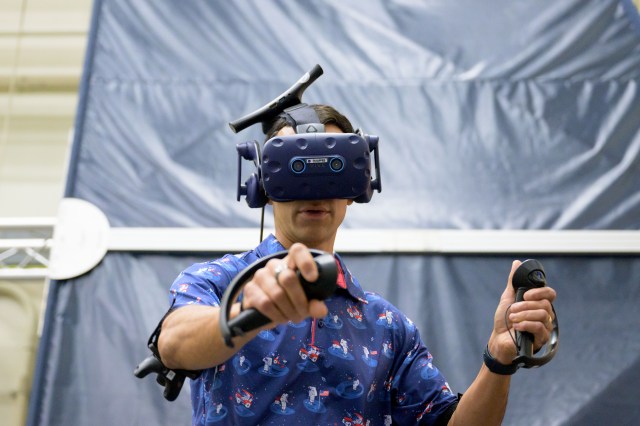
Through Astronaut Eyes, Virtual Reality Propels Gateway Forward

How NASA Spotted El Niño Changing the Saltiness of Coastal Waters
- Search All NASA Missions
- A to Z List of Missions
- Upcoming Launches and Landings
- Spaceships and Rockets
- Communicating with Missions
- James Webb Space Telescope
- Hubble Space Telescope
- Why Go to Space
- Astronauts Home
- Commercial Space
- Destinations
- Living in Space
- Explore Earth Science
- Earth, Our Planet
- Earth Science in Action
- Earth Multimedia
- Earth Science Researchers
- Pluto & Dwarf Planets
- Asteroids, Comets & Meteors
- The Kuiper Belt
- The Oort Cloud
- Skywatching
- The Search for Life in the Universe
- Black Holes
- The Big Bang
- Dark Energy & Dark Matter
- Earth Science
- Planetary Science
- Astrophysics & Space Science
- The Sun & Heliophysics
- Biological & Physical Sciences
- Lunar Science
- Citizen Science
- Astromaterials
- Aeronautics Research
- Human Space Travel Research
- Science in the Air
- NASA Aircraft
- Flight Innovation
- Supersonic Flight
- Air Traffic Solutions
- Green Aviation Tech
- Drones & You
- Technology Transfer & Spinoffs
- Space Travel Technology
- Technology Living in Space
- Manufacturing and Materials
- Science Instruments
- For Kids and Students
- For Educators
- For Colleges and Universities
- For Professionals
- Science for Everyone
- Requests for Exhibits, Artifacts, or Speakers
- STEM Engagement at NASA
- NASA's Impacts
- Centers and Facilities
- Directorates
- Organizations
- People of NASA
- Internships
- Our History
- Doing Business with NASA
- Get Involved
- Aeronáutica
- Ciencias Terrestres
- Sistema Solar
- All NASA News
- Video Series on NASA+
- Newsletters
- Social Media
- Media Resources
- Upcoming Launches & Landings
- Virtual Events
- Sounds and Ringtones
- Interactives
- STEM Multimedia

Altitude Chamber Gets Upgrade for Artemis II, Spacecraft Testing Begins
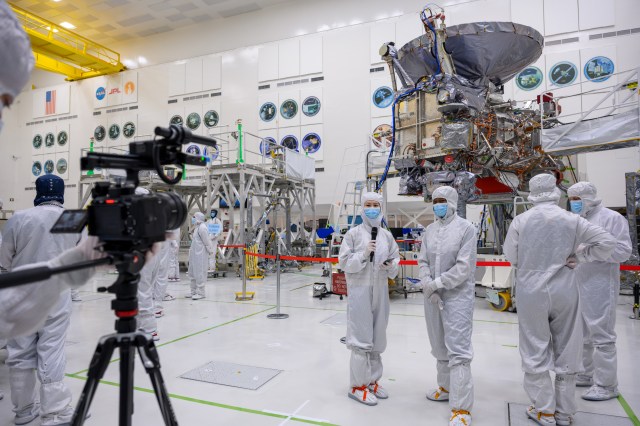

Media Get Close-Up of NASA’s Jupiter-Bound Europa Clipper

NASA’s PACE Data on Ocean, Atmosphere, Climate Now Available

NASA Shares Medical Expertise with New Space Station Partners

From NASA’s First Astronaut Class to Artemis II: The Importance of Military Jet Pilot Experience
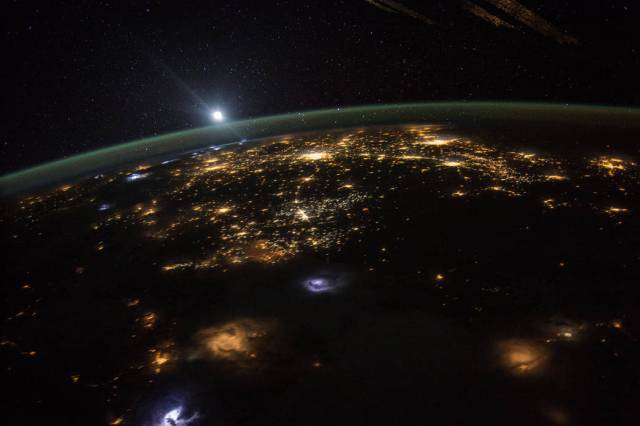
Commercial Space Frequently Asked Questions

NASA’s Lola Fatoyinbo Receives Royal Geographical Society Prize

More Than 36,000 Volunteers Helped Do NASA Eclipse Science

NASA Names Finalists of the Power to Explore Challenge

NASA’s TESS Temporarily Pauses Science Observations
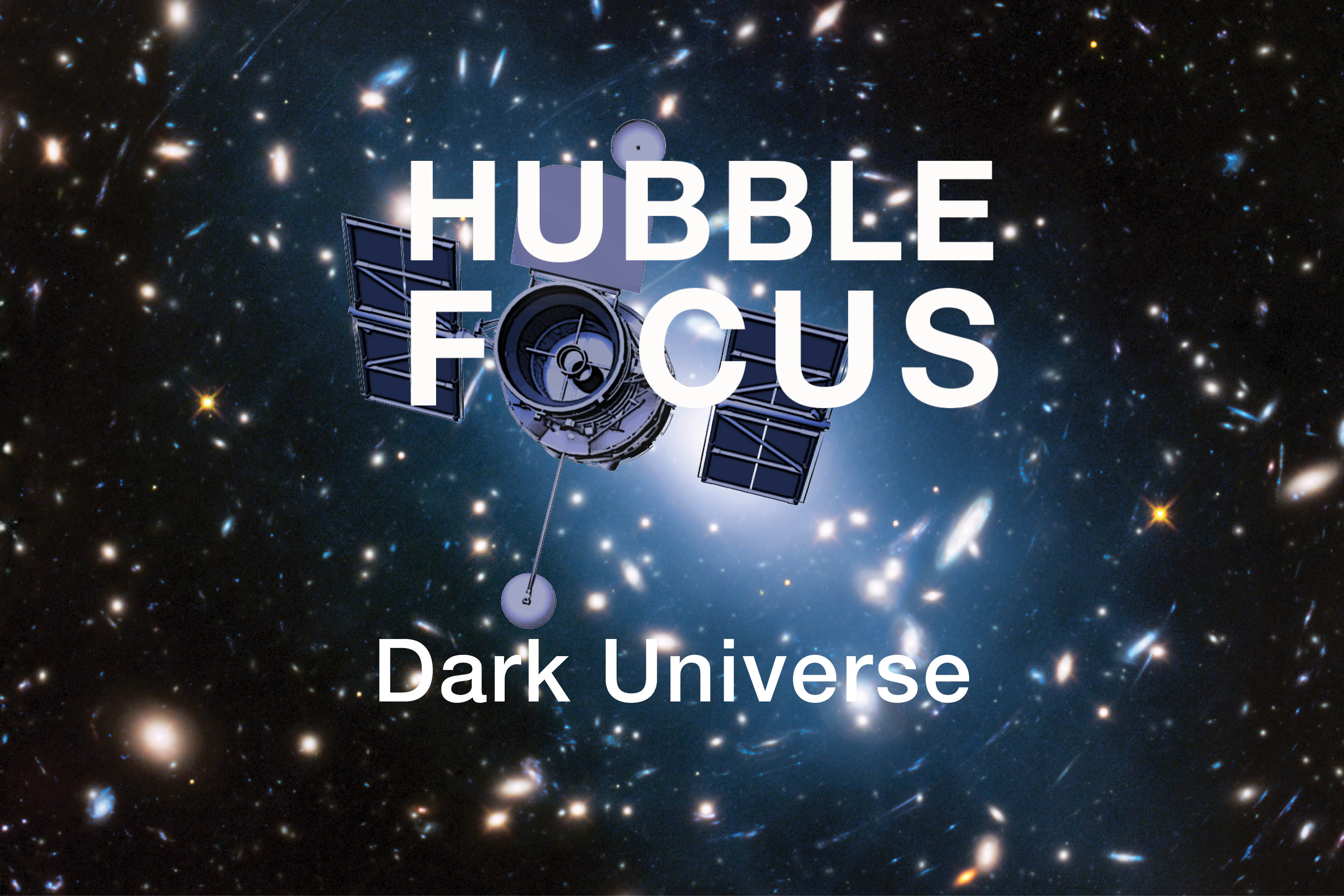
NASA’s New Hubble E-Book Spotlights Universe’s Best-Kept Dark Secrets

Accelerating Informatics for Earth Science

NASA Langley Team to Study Weather During Eclipse Using Uncrewed Vehicles

NASA Noise Prediction Tool Supports Users in Air Taxi Industry

ARMD Solicitations

NASA’s SERT II: ‘A Genuine Space Success Story’

Tech Today: Synthetic DNA Diagnoses COVID, Cancer

NASA Partnerships Bring 2024 Total Solar Eclipse to Everyone

Launch Week Event Details

La presentación del X-59 de la NASA personifica la tradición aeronáutica
45 years ago: voyager 1 begins its epic journey to the outer planets and beyond, johnson space center.
Forty-five years ago, the Voyager 1 spacecraft began an epic journey that continues to this day. The second of a pair of spacecraft, Voyager 1 lifted off on Sept. 5, 1977, 16 days after its twin left on a similar voyage. NASA’s Jet Propulsion Laboratory (JPL) in Pasadena, California, managed the two spacecraft on their missions to explore the outer planets. Taking advantage of a rare planetary alignment to use the gravity of one planet to redirect the spacecraft to the next, the Voyagers planned to use Jupiter’s gravity to send them on to explore Saturn and its large moon Titan. They carried sophisticated instruments to conduct their in-depth explorations of the giant planets. Both spacecraft continue to return data as they make their way out of our solar system and enter interstellar space.
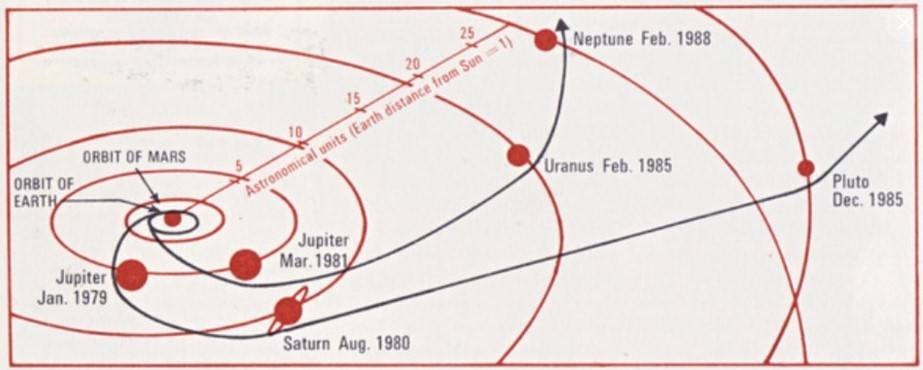
In the 1960s, mission designers at JPL noted that the next occurrence of a once-every-175-year alignment of the outer planets would happen in the late 1970s. A spacecraft could take advantage of this opportunity to fly by Jupiter and use its gravity to bend its trajectory to visit Saturn, and repeat the process to also visit Uranus, Neptune, and Pluto. Launching several missions to visit each planet individually would take much longer and cost much more. The original plan to send two pairs of Thermoelectric Outer Planet Spacecraft on these Grand Tours proved too costly leading to its cancellation in 1971. The next year, NASA approved a scaled-down version of the project to send a pair of Mariner-class spacecraft in 1977 to explore just Jupiter and Saturn, with an expected five-year operational life. On March 7, 1977, NASA Administrator James C. Fletcher announced the renaming of these Mariner Jupiter/Saturn 1977 spacecraft as Voyager 1 and 2. Scientists held out hope that one of them could ultimately visit Uranus and Neptune, thereby fulfilling most of the original Grand Tour’s objectives – Pluto would have to wait several decades for its first visit.
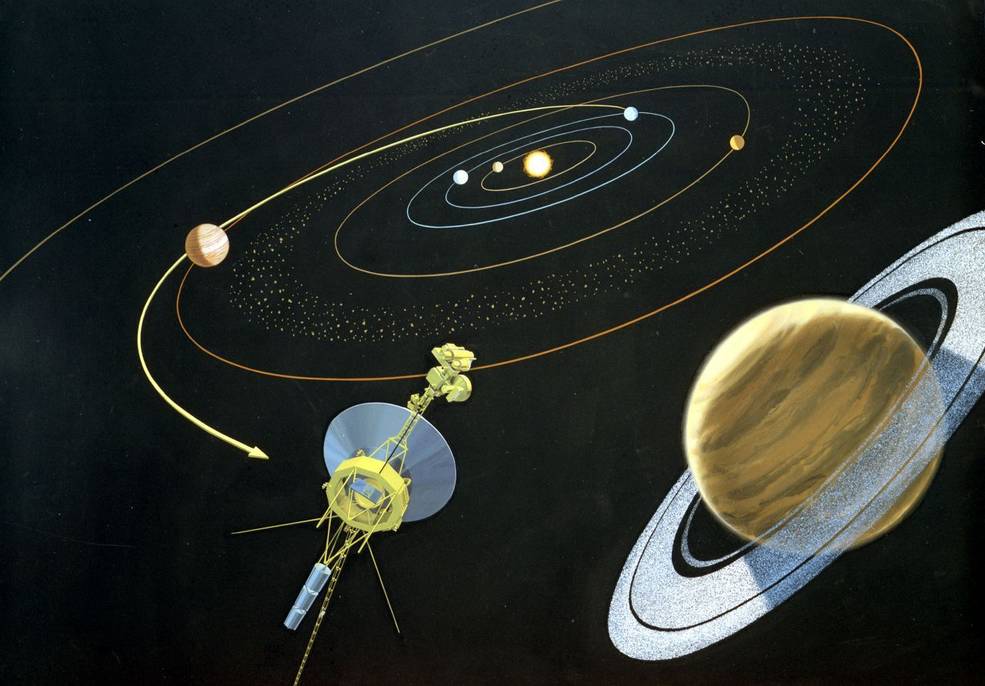
Each Voyager carried a suite of 11 instruments to study the planets during each encounter and to learn more about interplanetary space in the outer reaches of the solar system, including:
- An imaging science system consisting of narrow-angle and wide-angle cameras to photograph the planet and its satellites.
- A radio science system to determine the planet’s physical properties.
- An infrared interferometer spectrometer to investigate local and global energy balance and atmospheric composition.
- An ultraviolet spectrometer to measure atmospheric properties.
- A magnetometer to analyze the planet’s magnetic field and interaction with the solar wind.
- A plasma spectrometer to investigate microscopic properties of plasma ions.
- A low-energy charged particle device to measure fluxes and distributions of ions.
- A cosmic ray detection system to determine the origin and behavior of cosmic radiation.
- A planetary radio astronomy investigation to study radio emissions from Jupiter.
- A photopolarimeter to measure the planet’s surface composition.
- A plasma wave system to study the planet’s magnetosphere.
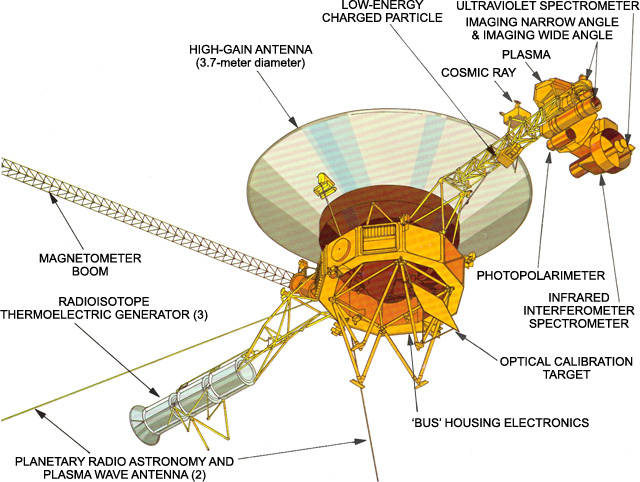
Voyager 1 lifted off on Sept. 5, 1977, atop a Titan IIIE-Centaur rocket from Launch Complex 41 at Cape Canaveral Air Force Station, now Cape Canaveral Space Force Station, in Florida. Two weeks after its launch, from a distance of 7.25 million miles, Voyager 1 turned its camera back toward its home planet and took the first single-frame image of the Earth-Moon system. The spacecraft successfully crossed the asteroid belt between Dec. 10, 1977, and Sept. 8, 1978.
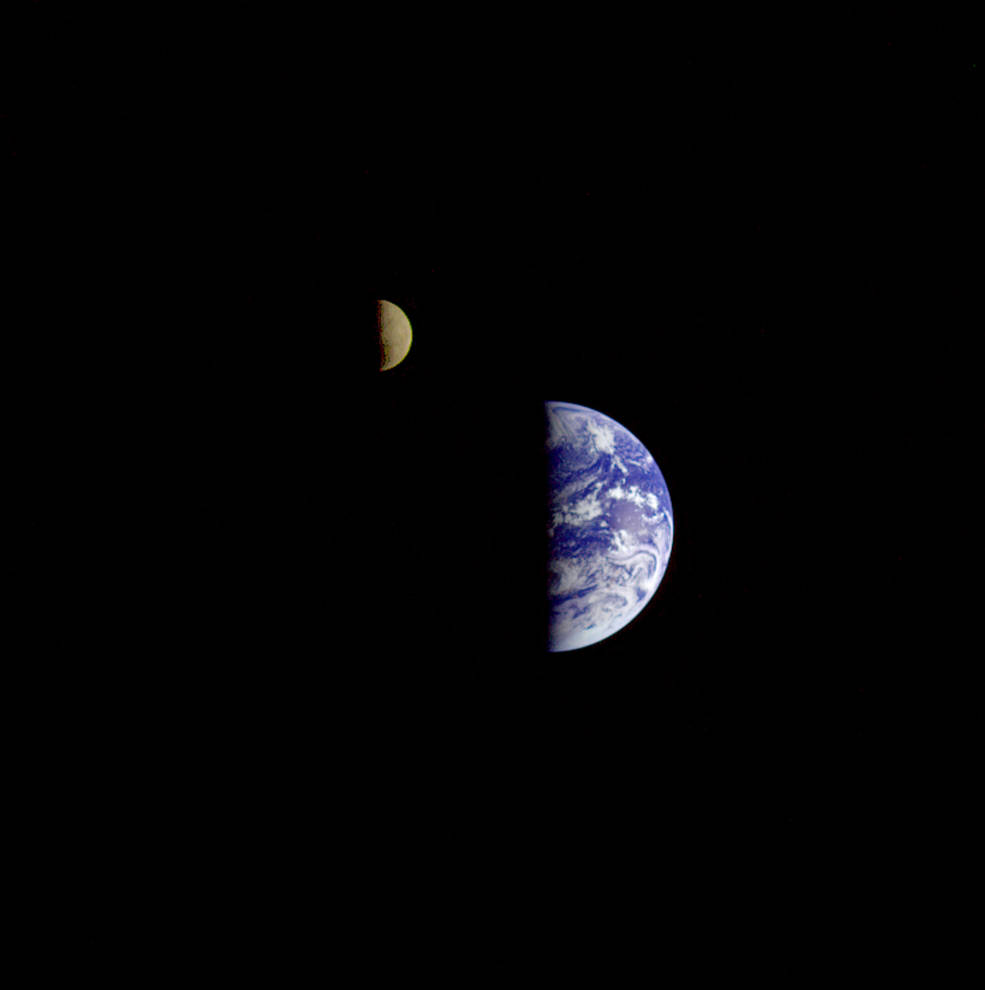
Although Voyager 1 launched two weeks after its twin, it traveled on a faster trajectory and arrived at Jupiter four months earlier. Voyager 1 conducted its observations of Jupiter between Jan. 6 and April 13, 1979, making its closest approach of 216,837 miles from the planet’s center on March 5. The spacecraft returned 19,000 images of the giant planet, many of Jupiter’s satellites, and confirmed the presence of a thin ring encircling it. Its other instruments returned information about Jupiter’s atmosphere and magnetic field. Jupiter’s massive gravity field bent the spacecraft’s trajectory and accelerated it toward Saturn.
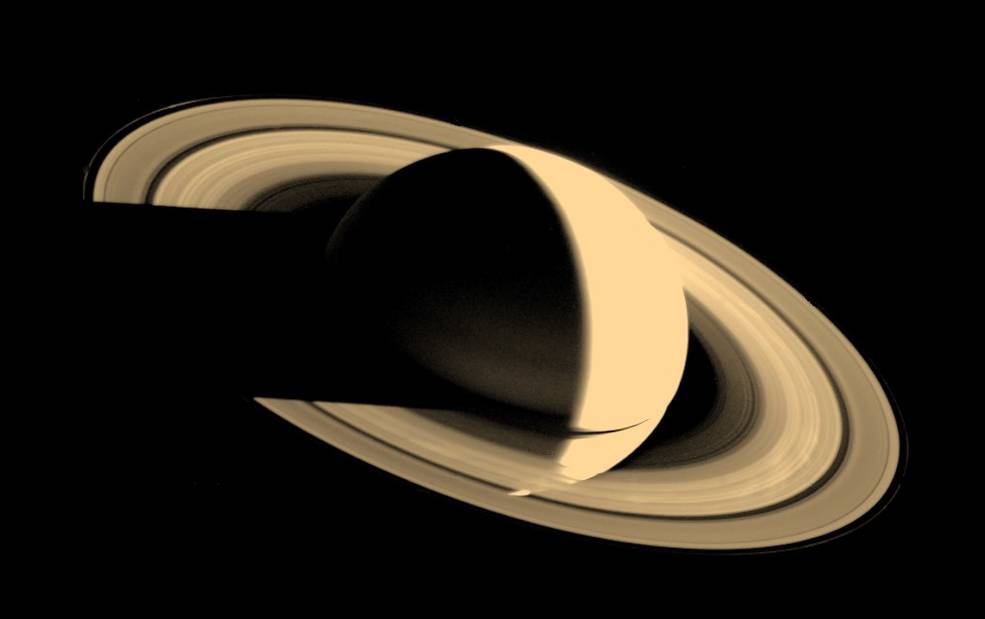
Voyager 1 began its long-range observations of Saturn on Aug. 22, 1980, passed within 114,500 miles of the planet’s center on Nov. 12, and concluded its studies on Dec. 14. Because of its interest to scientists, mission planners chose the spacecraft’s trajectory to make a close flyby of Saturn’s largest moon Titan – the only planetary satellite with a dense atmosphere – just before the closest approach to the planet itself. This trajectory, passing over Saturn’s south pole and bending north over the plane of the ecliptic, precluded Voyager 1 from making any additional planetary encounters. The spacecraft flew 4,033 miles from Titan’s center, returning images of its unbroken orange atmosphere and high-altitude blue haze layer. During the encounter, Voyager 1 returned 16,000 photographs, imaging Saturn, its rings, many of its known satellites and discovering several new ones, while its instruments returned data about Saturn’s atmosphere and magnetic field.

On Feb. 14, 1990, more than 12 years after it began its journey from Earth and shortly before controllers permanently turned off its cameras to conserve power, Voyager 1 spun around and pointed them back into the solar system. In a mosaic of 60 images, it captured a “family portrait” of six of the solar system’s planets, including a pale blue dot called Earth more than 3.7 billion miles away. Fittingly, these were the last pictures returned from either Voyager spacecraft. On Feb. 17, 1998, Voyager 1 became the most distant human-made object, overtaking the Pioneer 10 spacecraft on their way out of the solar system. In February 2020, to commemorate the photograph’s 30th anniversary, NASA released a remastered version of the image of Earth as Pale Blue Dot Revisited .
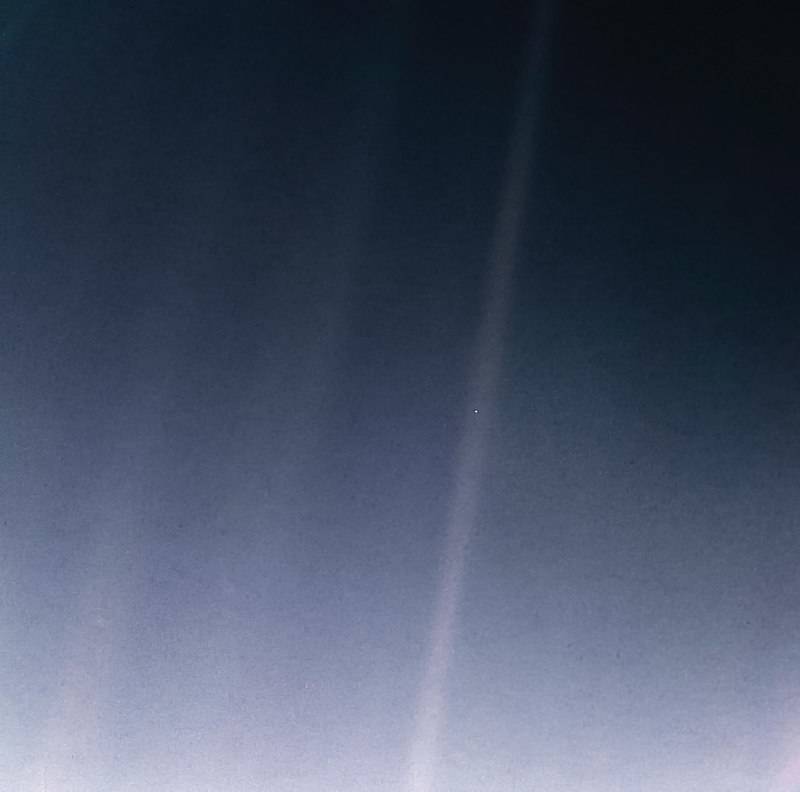
On New Year’s Day 1990, both spacecraft officially began the Voyager Interstellar Mission as they inexorably made their escape from our solar system. On Aug. 25, 2012, Voyager 1 passed beyond the heliopause, the boundary between the heliosphere, the bubble-like region of space created by the Sun, and the interstellar medium. Its twin followed suit six years later. Today , 45 years after its launch and 14.6 billion miles from Earth, four of Voyager 1’s 11 instruments continue to return useful data, having now spent 10 years in interstellar space. Signals from the spacecraft take nearly 22 hours to reach Earth, and 22 hours for Earth-based signals to reach the spacecraft. Engineers expect that the spacecraft will continue to return data from interstellar space until about 2025 when it will no longer be able to power its systems. And just in case an alien intelligence finds it one day, Voyager 1 like its twin carries a gold-plated record that contains information about its home planet, including recordings of terrestrial sounds, music, and greetings in 55 languages. Engineers at NASA thoughtfully included Instructions on how to play the record.
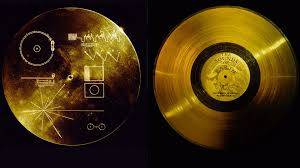
The voyage continues…
Voyager Reaches Interstellar Space
Your browser cannot play the provided video file(s).
(Music) Voyager 1 has left the bubble around the sun and entered interstellar space the space between stars.
It's amazing that Voyager has operated 36 years.
(sound of launch)
Launched in 1977, travelled passed the gas giant planets in our solar system and now off into interstellar space. It's a great journey.
We have an instrument on Voyager, which can measure the density of the ions, the plasma, which is out there.
In March of 2012 it turns out there was a massive eruption from the sun, which eventually reached Voyager 1 in April of 2013.
When that blast wave reached Voyager, it caused the plasma around Voyager to vibrate or oscillate in a certain particular tone.
Literally, they're the sounds of interstellar space.
(Sound of interstellar space)
And by measuring that sound wave, we could measure the density of the plasma and we're amazed to find out that we were in interstellar space.
This is a historic milestone in the great journeys of exploration that have been undertaken by humankind.
The Very Large Baseline Array took a radio image of Voyager 1 spacecraft slightly over 11-billion miles from the Earth.
And it's a very small radio dot amongst a sea of darkness.
It is quite remarkable when you think about it, that far off now at ever increasing differences, there's this little vehicle, two of them, which were built here many years ago and launched 36 years ago.
Now, on a journey that will basically last for billions of years.
NASA Jet Propulsion Laboratory, California Institute of Technology

Voyager 1 y 2: La Misión Interestelar
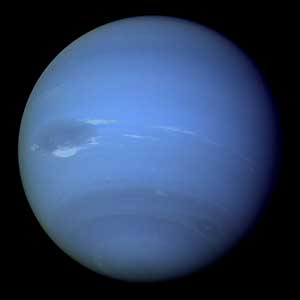
Imagen de Neptuno tomada por la nave espacial Voyager 2. Imagen crédito: NASA
NASA tiene hermosas fotos de cada planeta de nuestro sistema solar. Incluso tenemos imágenes del lejano Neptuno , como podemos apreciar en la foto de arriba.
Neptuno está demasiado lejos para que un astronauta viaje hasta allí con una cámara. Entonces, ¿cómo tenemos imágenes de lugares tan lejanos de nuestro sistema solar? Nuestros fotógrafos fueron dos naves espaciales llamadas ¡Voyager 1 y Voyager 2!
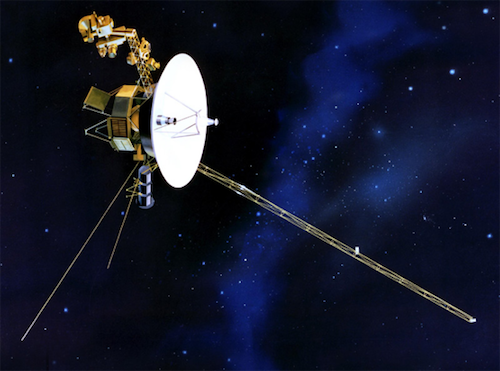
Representación artística de una de las naves espaciales Voyager. Imagen crédito: NASA
Las naves espaciales Voyager 1 y Voyager 2 fueron lanzadas desde la Tierra en 1977. Su misión fue explorar Júpiter y Saturno --y planetas que se encuentran más allá de nuestro sistema solar. Esta fue una gran hazaña. Ningún objeto hecho en el pasado por el ser humano, había intentado un viaje como éste.
Las dos naves espaciales tomaron decenas de miles de imágenes de Júpiter y Saturno. Las imágenes del Voyager 1 y 2 nos permitieron ver muchas cosas por primera vez. Por ejemplo, ellos capturaron fotos a detalle de las nubes y tormentas de Júpiter, y la estructura de los anillos de Saturno .
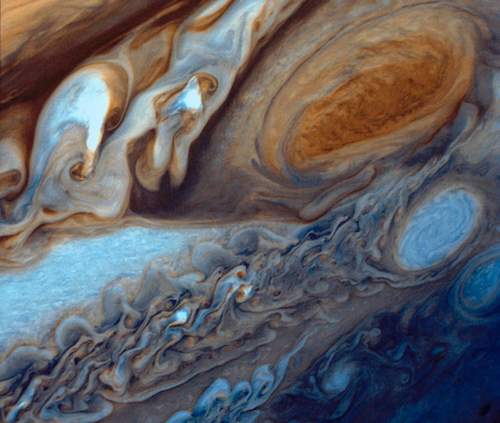
Imagen de las tormentas en Júpiter tomadas por la nave espacial Voyager 1. Crédito: NASA
Voyager 1 y 2 también descubrieron volcanes activos en Io, una de las lunas de Júpiter , y mucho más. Voyager 2 también tomó imágenes de Urano y Neptuno. En conjunto, la misión Voyager descubrió 22 lunas.
Desde entonces, estas astronaves continúan su viaje alejándose de nosotros. Voyager 1 y 2 están ahora tan lejos que han llegado al espacio interestelar --la región entre las estrellas. Ninguna otra nave espacial ha viajado tan lejos.
¿A dónde irá Voyager después?
¡Mira éste video para descubrir qué hay más allá de nuestro sistema solar!
Ambas naves espaciales continúan enviando información de regreso a la Tierra. Estos datos nos ayudarán a entender acerca de las condiciones en el distante sistema solar y el espacio interestelar.
Los Voyager tienen suficiente combustible y energía para operar hasta el 2025 y más allá. Después de algún tiempo de esto, ya no podrán comunicarse con la Tierra. A menos que algo los detenga, continuarán pasando por nuevas estrellas una y otra vez por muchos miles de años.
Cada nave espacial Voyager contiene un mensaje. Ambas lleva consigo un disco de oro con escenas y sonidos de la Tierra. Los discos también contienen música y saludos en diferentes idiomas. Por lo cual, si vida inteligente encuentra alguna vez estas naves espaciales, ¡podrán saber acerca de la Tierra y de nosotros!
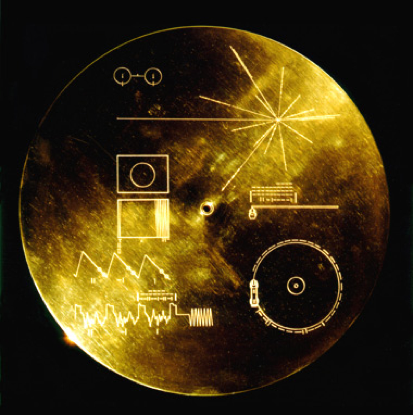
Foto del disco de oro que se envió al espacio en ambos Voyagers 1 y 2. Imagen crédito: NASA/JPL-Caltech
¡Más sobre nuestro universo!

¿Dónde comienza el espacio interestelar?

Buscando otros planetas como el nuestro.

¡Juega al Explorador Galáctico!
More about our universe!

Where does interstellar space begin?

Searching for other planets like ours

Play Galactic Explorer!

- The Contents
- The Making of
- Where Are They Now
- Frequently Asked Questions
- Q & A with Ed Stone
golden record
Where are they now.
- frequently asked questions
- Q&A with Ed Stone
Mission Status
Instrument status.

Where are the Voyagers now?
To learn more about Voyager, zoom in and give the spacecraft a spin. View the full interactive experience at Eyes on the Solar System . Credit: NASA/JPL-Caltech
View Voyager
Space Flight Operations Schedule (SFOS)
SFOS files showing Voyager activity on Deep Space Network (DSN)
2024 Tracking Schedule
2023 tracking schedule, 2022 tracking schedule, 2021 tracking schedule, 2020 tracking schedule, 2019 tracking schedule, 2018 tracking schedule, 2017 tracking schedule, 2016 tracking schedule, 2015 tracking schedule, 2014 tracking schedule, 2013 tracking schedule, 2012 tracking schedule, 2011 tracking schedule, 2010 tracking schedule, 2009 tracking schedule, 2008 tracking schedule, 2007 tracking schedule, 2006 tracking schedule, 2005 tracking schedule, 2004 tracking schedule, 2003 tracking schedule, 2002 tracking schedule, 2001 tracking schedule, 2000 tracking schedule, 1999 tracking schedule, 1998 tracking schedule, 1997 tracking schedule, 1996 tracking schedule, 1995 tracking schedule, 1994 tracking schedule.
Voyager 1 (Original Score)
October 1, 2016 10 Songs, 39 minutes ℗ 2016 Sky Harbor Entertainment
More By Adam Young
You might also like.
Various Artists
Jeff Williams
Howard Shore
Two Steps From Hell
Alan Silvestri
Steve Jablonsky
Select a country or region
Africa, middle east, and india.
- Côte d’Ivoire
- Congo, The Democratic Republic Of The
- Guinea-Bissau
- Niger (English)
- Congo, Republic of
- Saudi Arabia
- Sierra Leone
- South Africa
- Tanzania, United Republic Of
- Turkmenistan
- United Arab Emirates
Asia Pacific
- Indonesia (English)
- Lao People's Democratic Republic
- Malaysia (English)
- Micronesia, Federated States of
- New Zealand
- Papua New Guinea
- Philippines
- Solomon Islands
- Bosnia and Herzegovina
- France (Français)
- Deutschland
- Luxembourg (English)
- Moldova, Republic Of
- North Macedonia
- Portugal (Português)
- Türkiye (English)
- United Kingdom
Latin America and the Caribbean
- Antigua and Barbuda
- Argentina (Español)
- Bolivia (Español)
- Virgin Islands, British
- Cayman Islands
- Chile (Español)
- Colombia (Español)
- Costa Rica (Español)
- República Dominicana
- Ecuador (Español)
- El Salvador (Español)
- Guatemala (Español)
- Honduras (Español)
- Nicaragua (Español)
- Paraguay (Español)
- St. Kitts and Nevis
- Saint Lucia
- St. Vincent and The Grenadines
- Trinidad and Tobago
- Turks and Caicos
- Uruguay (English)
- Venezuela (Español)
The United States and Canada
- Canada (English)
- Canada (Français)
- United States
- Estados Unidos (Español México)
- الولايات المتحدة
- États-Unis (Français France)
- Estados Unidos (Português Brasil)
- 美國 (繁體中文台灣)
NASA engineers discover why Voyager 1 is sending a stream of gibberish from outside our solar system
Voyager 1 has been sending a stream of garbled nonsense since November. Now NASA engineers have identified the fault and found a potential workaround.
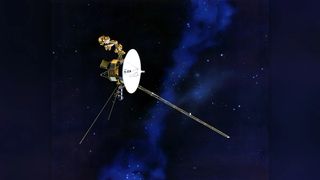
For the past five months, the Voyager 1 spacecraft has been sending a steady stream of unreadable gibberish back to Earth. Now, NASA engineers finally know why.
The 46-year-old spacecraft sends regular radio signals as it drifts further from our solar system . But in November 2023, the signals suddenly became garbled, meaning scientists were unable to read any of its data, and they were left mystified about the fault's origins.
In March, NASA engineers sent a command prompt, or "poke," to the craft to get a readout from its flight data subsystem (FDS) — which packages Voyager 1's science and engineering data before beaming it back to Earth.
After decoding the spacecraft's response, the engineers have found the source of the problem: The FDS's memory has been corrupted.
Related: NASA's Voyager 1 sends readable message to Earth after 4 nail-biting months of gibberish
"The team suspects that a single chip responsible for storing part of the affected portion of the FDS memory isn't working," NASA said in a blog post Wednesday (March 13) . "Engineers can't determine with certainty what caused the issue. Two possibilities are that the chip could have been hit by an energetic particle from space or that it simply may have worn out after 46 years."
— NASA hears 'heartbeat' signal from Voyager 2 probe a week after losing contact
— Historic space photo of the week: Voyager 2 spies a storm on Saturn 42 years ago
— NASA reestablishes full contact with Voyager 2 probe after nail-biting 2-week blackout
Although it may take several months, the engineers say they can find a workaround to run the FDS without the fried chip — restoring the spacecraft's messaging output and enabling it to continue to send readable information from outside our solar system.
Sign up for the Live Science daily newsletter now
Get the world’s most fascinating discoveries delivered straight to your inbox.
Launched in 1977, Voyager 1 zipped past Saturn and Jupiter in 1979 and 1980 before flying out into interstellar space in 2012. It is now recording the conditions outside of the sun's protective magnetic field , or heliosphere, which blankets our solar system.
Voyager 1 is currently more than 15 billion miles (24 billion kilometers) from Earth, and it takes 22.5 hours for any radio signal to travel from the craft to our planet.

Ben Turner is a U.K. based staff writer at Live Science. He covers physics and astronomy, among other topics like tech and climate change. He graduated from University College London with a degree in particle physics before training as a journalist. When he's not writing, Ben enjoys reading literature, playing the guitar and embarrassing himself with chess.
NASA spacecraft snaps mysterious 'surfboard' orbiting the moon. What is it?
The moon is getting its own time zone, White House memo to NASA reveals
Why I watched the solar eclipse with my kids, a goose and 2,000 trees
- TorbjornLarsson Bon voyage, Voyager! Reply
- Jay McHue What if aliens are doing it to try to communicate with us? 🤪 Reply
Jay McHue said: What if aliens are doing it to try to communicate with us? 🤪
admin said: Voyager 1 has been sending a stream of garbled nonsense since November. Now NASA engineers have identified the fault and found a potential workaround. NASA engineers discover why Voyager 1 is sending a stream of gibberish from outside our solar system : Read more
sourloaf said: What does FSB mean?
Rusty Lugnuts said: Where are you seeing "FSB"? The closest thing I can see in the article is "FDS". In modern computers, FSB would most likely refer to the Fr0nt S1ide Bu5, though I have no idea if a system as old as Voyagers, let alone engineered so specifically, would have an FSB. (apparently I can't spell out "Fr0nt S1ide Bu5" or my post gets flagged as spam or inappropriate??)
- SkidWard Just cut the % of ram needed... skip the bad sectors Reply
- kloudykat FDS = fl1ght da1a sub5ystem5 Reply
- 5ft24dave This is pretty old news, like 6 months old. Are you guys just now discovering this? Reply
Commodore Browncoat said: That's about as sane a theory as many of the others that have become ridiculously popular in the past several years, so sure - why not? What reply do you think we should send?
- View All 11 Comments
Most Popular
By Peter Ray Allison April 10, 2024
By Tom Metcalfe April 09, 2024
By Rebecca Sohn April 09, 2024
By Stephanie Pappas April 09, 2024
By Samantha Mathewson April 09, 2024
By Nicoletta Lanese April 09, 2024
By Sascha Pare April 09, 2024
By Emily Cooke April 09, 2024
By Harry Baker April 09, 2024
- 2 Here are the best photos of the April 8 total solar eclipse over North America
- 3 Part of the San Andreas fault may be gearing up for an earthquake
- 4 Pet fox with 'deep relationship with the hunter-gatherer society' buried 1,500 years ago in Argentina
- 5 NASA engineers discover why Voyager 1 is sending a stream of gibberish from outside our solar system
- 2 Pet fox with 'deep relationship with the hunter-gatherer society' buried 1,500 years ago in Argentina
- 3 No, you didn't see a solar flare during the total eclipse — but you may have seen something just as special
- 4 Neolithic women in Europe were tied up and buried alive in ritual sacrifices, study suggests
- 5 Superfast drone fitted with new 'rotating detonation rocket engine' approaches the speed of sound


NASA's Ingenious Efforts to Restore Voyager 1's Interstellar Communications on May,2022
V oyager 1, the venerable space probe and humanity’s most distant emissary, has encountered a communication hurdle that has persisted for months, leading to a valiant effort by NASA engineers to comprehend and rectify the anomaly.
For over 45 years, Voyager 1 has been gliding through the cosmos, and in its lifetime, it has delivered invaluable data on planets like Jupiter and Saturn, as well as a solitary image of Earth from the outskirts of our solar system. Yet, as it cruises over 15 billion miles from Earth, it faces a unique challenge: a breakdown in the way it communicates its observations and status back to ground control.
In May 2022, NASA’s Jet Propulsion Laboratory (JPL) engineers noticed the glitch when Voyager 1 began transmitting nonsensical data. This data, meant to inform mission controllers about the spacecraft’s operations and scientific findings, is crucial for the continuous assessment of the mission’s health and objectives. A JPL spokesperson highlighted the efforts made to resolve the issue: “The team continues information gathering and are preparing some steps that they’re hopeful will get them on a path to either understand the root of the problem and/or solve it.”
The glitch appears to be a discord between the spacecraft’s flight data system (FDS) and its telemetry modulation unit (TMU). Normally, the FDS would collect and package data for transmission to Earth, but the TMU has been sending a repeating pattern of ones and zeroes, rendering the data unintelligible.
Despite this setback, the mission team has made a breakthrough. In March 2023, after sending a ‘poke’ to the spacecraft, a signal was received that stood out from the garbled data stream. A Deep Space Network engineer decoded this and found it contained a readout of the entire FDS’s memory, a potential treasure trove for diagnosing the problem.
The issue is compounded by the enormous distance signals must travel, taking approximately 22 hours each way, leading to a slow, iterative process of trial and error as engineers send commands and await the spacecraft’s response. It’s a process the JPL spokesperson described, noting, “After they do that, they spend a few days digesting the information they got, consulting old documents to see if they can make sense of the little bits of information they can glean from things (since the telemetry data itself is unusable), and then send another command.”
Despite the challenges, the mission team remains hopeful. The wealth of data collected before the communication breakdown continues to shed light on the conditions of interstellar space, and the Voyager probes’ ongoing journey into the cosmos is a testament to human ingenuity and curiosity.
As NASA’s engineers labor to parse the received memory readout and develop potential solutions, Voyager 1’s mission remains a symbol of human achievement. Although the issue remains unresolved, the data sent back before the problem began provides an extensive understanding of interstellar space, and the work to re-establish complete communication is evidence of NASA’s relentless pursuit of knowledge.
Relevant articles:
– NASA Is Still Fighting to Save Its Historic Voyager 1 … , Gizmodo, Mar 7, 2024
– Voyager 1 sends back surprising response after ‘poke’ from NASA , CNN
– NASA finds clue while solving Voyager 1’s communication breakdown case , Space.com
– How was contact restored between NASA and Voyager 2? Here’s all you need to know about the ‘shout’ across interstellar space which retrieved the spacecraft , economictimes.com
![Voyager 1, the venerable space probe and humanity’s most distant emissary, has encountered a communication hurdle that has persisted for months, leading to a valiant effort by NASA engineers to comprehend and rectify the anomaly. For over 45 years, Voyager 1 has been gliding through the cosmos, and in its lifetime, it has delivered invaluable […] Voyager 1, the venerable space probe and humanity’s most distant emissary, has encountered a communication hurdle that has persisted for months, leading to a valiant effort by NASA engineers to comprehend and rectify the anomaly. For over 45 years, Voyager 1 has been gliding through the cosmos, and in its lifetime, it has delivered invaluable […]](https://img-s-msn-com.akamaized.net/tenant/amp/entityid/BB1l0TOd.img?w=768&h=512&m=6)
We finally know why NASA's Voyager 1 spacecraft stopped communicating — scientists are working on a fix
The first spacecraft to explore beyond the solar system started spouting gibberish late last year. Now, NASA knows why.

NASA engineers have discovered the cause of a communications breakdown between Earth and the interstellar explorer Voyager 1. It would appear that a small portion of corrupted memory exists in one of the spacecraft's computers.
The glitch caused Voyager 1 to send unreadable data back to Earth, and is found in the NASA spacecraft's flight data subsystem (FDS). That's the system responsible for packaging the probe's science and engineering data before the telemetry modulation unit (TMU) and radio transmitter send it back to mission control.
The source of the issue began to reveal itself when Voyager 1 operators sent the spacecraft a "poke" on March 3, 2024. This was intended to prompt FDS to send a full memory readout back to Earth.
The readout confirmed to the NASA team that about 3% of the FDS memory had been corrupted, and that this was preventing the computer from carrying out its normal operations.
Related: NASA finds clue while solving Voyager 1's communication breakdown case
Launched in 1977, Voyager 1 became the first human-made object to leave the solar system and enter interstellar space in 2012. Voyager 2 followed its spacecraft sibling out of the solar system in 2018, and is still operational and communicating well with Earth.
After 11 years of interstellar exploration, in Nov. 2023, Voyager 1's binary code — the computer language it uses to communicate with Earth — stopped making sense. Its 0's and 1's didn't mean anything anymore.
Get the Space.com Newsletter
Breaking space news, the latest updates on rocket launches, skywatching events and more!
"Effectively, the call between the spacecraft and the Earth was still connected, but Voyager's 'voice' was replaced with a monotonous dial tone," Voyager 1's engineering team previously told Space.com .

The team strongly suspects this glitch is the result of a single chip that's responsible for storing part of the affected portion of the FDS memory ceasing to work.
Currently, however, NASA can’t say for sure what exactly caused that particular issue. The chip could have been struck by a high-speed energetic particle from space or, after 46 years serving Voyager 1, it may simply have worn out.
— Voyager 2: An iconic spacecraft that's still exploring 45 years on
— NASA's interstellar Voyager probes get software updates beamed from 12 billion miles away
— NASA Voyager 2 spacecraft extends its interstellar science mission for 3 more years
Voyager 1 currently sits around 15 billion miles (24 billion kilometers) from Earth, which means it takes 22.5 hours to receive a radio signal from it — and another 22.5 hours for the spacecraft to receive a response via the Deep Space Network's antennas. Solving this communication issue is thus no mean feat.
Yet, NASA scientists and engineers are optimistic they can find a way to help FDS operate normally, even without the unusable memory hardware.
Solving this issue could take weeks or even months, according to NASA — but if it is resolved, Voyager 1 should be able to resume returning science data about what lies outside the solar system.
Join our Space Forums to keep talking space on the latest missions, night sky and more! And if you have a news tip, correction or comment, let us know at: [email protected].

Robert Lea is a science journalist in the U.K. whose articles have been published in Physics World, New Scientist, Astronomy Magazine, All About Space, Newsweek and ZME Science. He also writes about science communication for Elsevier and the European Journal of Physics. Rob holds a bachelor of science degree in physics and astronomy from the U.K.’s Open University. Follow him on Twitter @sciencef1rst.
SpaceX launches advanced weather satellite for US Space Force (video)
SpaceX launches 23 Starlink satellites in nighttime liftoff (photos, video)
My formal 2024 solar eclipse apology
- jcs Funny timing for this article, when I am streaming an old Star Trek movie. So, surely this didn't cause a 3 byte glitch removing the O, Y and A from Voyager's name buffer? Get it? Reply
- bwana4swahili It is quite amazing it has lasted this long in a space environment. Reply
bwana4swahili said: It is quite amazing it has lasted this long in a space environment.
- HankySpanky So now we know even better for next time. Perhaps a spare chipset that is not redundant but is ready to take over, stored in a protective environment. A task NASA can handle. We'll find out in 100 year or so - if humanity still exists. Reply
HankySpanky said: So now we know even better for next time. Perhaps a spare chipset that is not redundant but is ready to take over, stored in a protective environment. A task NASA can handle. We'll find out in 100 year or so - if humanity still exists.
- Classical Motion I'm afraid it might self repair. And download galactic knowledge, then decide we are a danger. And turn around. Reply
Classical Motion said: I'm afraid it might self repair. And download galactic knowledge, then decide we are a danger. And turn around.
- jcs ROFLOL! And a hot bald chick delivering the bad news! Reply
- View All 8 Comments
Most Popular
By Tereza Pultarova April 11, 2024
By Keith Cooper April 11, 2024
By Jamie Carter April 11, 2024
By Mike Wall April 11, 2024
By Robert Z. Pearlman April 11, 2024
By Joe Rao April 10, 2024
By Robert Lea April 10, 2024
By Mike Wall April 10, 2024
By Brett Tingley April 10, 2024
By Jamie Carter April 10, 2024
By Jeff Spry April 10, 2024
- 2 Achoo! Baby star 'sneezes' tell astronomers a lot about their development
- 3 A NASA spacecraft spotted something weird orbiting the moon. It was just a lunar neighbor (photos)
- 4 Monster star gains magnetic personality following stellar merger
- 5 Car-sized asteroid gives Earth a super-close shave with flyby closer than some satellites

COMMENTS
Holborne, Paueans, Galliards, Almains and Other Short Aeirs, "The Fairie Round," performed by David Munrow and the Early Music Consort of London. 1:17; Solomon Islands, panpipes, collected by the Solomon Islands Broadcasting Service. 1:12; Peru, wedding song, recorded by John Cohen. 0:38; China, ch'in, "Flowing Streams," performed by Kuan P'ing ...
Here's Dr Vicinanza's detailed breakdown of the piece: "The main melody line comes from the sonification of the cosmic ray count from the LECP and it is played by the second violins for data collected from 1977 to 2012 - the year when Voyager 1 left the solar system - then by flute, piccolo and glockenspiel. "Piano and French horns ...
The Voyager Golden Records are two phonograph records that were included aboard both Voyager spacecraft launched in 1977. The records contain sounds and imag...
Site Manager: Jon Nelson Webmasters: Anil Natha, Luis Espinoza Webmasters: Anil Natha, Luis Espinoza
Launched by NASA a little over four decades ago, Voyager 1 now throttles away from Earth at 17 m/s, carrying equipment that still manages to relay information to Earth despite being past its prime ...
The music of NASA's Voyager Golden Records presented by Royal College of Music student Alec Coles-Aldridge. On 25 August 2012, the Voyager 1 spacecraft entered interstellar space, the matter that exists between the star systems in a galaxy. This achievement made Voyager 1 the furthest travelling man-made object in history.
Voyager 1 is one of the two deep space probes sent by NASA to study the outer planets and the frontiers of the Solar System. The 722 -kg (1,590-lb) spacecraft was launched on September 5, 1977 and ...
Voyager 1 is a space probe launched by NASA on September 5, 1977, as part of the Voyager program to study the outer Solar System and the interstellar space beyond the Sun's heliosphere. It was launched 16 days after its twin Voyager 2.
Voyager 1 was the first spacecraft to cross the heliosphere, the boundary where the influences outside our solar system are stronger than those from our Sun. Voyager 1 is the first human-made object to venture into interstellar space. Voyager 1 discovered a thin ring around Jupiter and two new Jovian moons: Thebe and Metis.
First, it takes a long time to communicate with Voyager 1. Traveling at the speed of light, the radio signals used to command the spacecraft take 22.5 hours to travel 15 billion miles—and 22.5 ...
Today, 45 years after its launch and 14.6 billion miles from Earth, four of Voyager 1's 11 instruments continue to return useful data, having now spent 10 years in interstellar space. Signals from the spacecraft take nearly 22 hours to reach Earth, and 22 hours for Earth-based signals to reach the spacecraft.
Voyager 1, already the most distant human-made object in the cosmos, reaches 100 astronomical units from the sun on Tuesday, August 15 at 5:13 p.m. Eastern time (2:13 p.m. Pacific time). That means the spacecraft, which launched nearly three decades ago, will be 100 times more distant from the sun than Earth is. ...
Voyager 1 has left the bubble around the sun and entered interstellar space the space between stars. It's amazing that Voyager has operated 36 years. Launched in 1977, travelled passed the gas giant planets in our solar system and now off into interstellar space. It's a great journey. We have an instrument on Voyager, which can measure the ...
Sonidos de la Tierra. El disco de oro de las Voyager (titulado en inglés como "The Sounds of Earth", en español como Sonidos de la Tierra) son dos discos fonográficos de cobre bañado en oro y de 30 cm de diámetro [1] que acompañan a las sondas espaciales Voyager, lanzadas en 1977 y que tardarán 40 000 años en alcanzar las proximidades de la estrella más cercana a nuestro sistema solar.
This is my fourth official audio release as far as No Copyright Music goes. Inspired by all those great classic movies about space travel, adventures in dist...
A medida que la Voyager 1 se aleja del sistema solar, los investigadores están escuchando "música interestelar" (ondas de plasma a.k.a.) para aprender más ac...
Las naves espaciales Voyager 1 y Voyager 2 fueron lanzadas desde la Tierra en 1977. Su misión fue explorar Júpiter y Saturno --y planetas que se encuentran más allá de nuestro sistema solar. Esta fue una gran hazaña. Ningún objeto hecho en el pasado por el ser humano, había intentado un viaje como éste. Las dos naves espaciales tomaron ...
Note: Because Earth moves around the sun faster than Voyager 1 is speeding away from the inner solar system, the distance between Earth and the spacecraft actually decreases at certain times of year. Distance from Sun: This is a real-time indicator of Voyagers' straight-line distance from the sun in astronomical units (AU) and either miles (mi ...
Hasta hace poco, todas las naves espaciales de la historia habían realizado sus mediciones dentro de nuestra heliosfera, la burbuja magnética influenciada por nuestro Sol. Hasta el 25 de agosto de 2012, cuando Voyager 1 cruzó el límite de la heliosfera, convirtiéndose en el primer objeto creado por humanos en entrar y medir el espacio interestelar.
As voyager 1 soars into interstellar space it manages to catch a music piece coming from earth despite being so far away. It causally listens as it flies off...
Voyager 1 (Original Score) Adam Young. SOUNDTRACK · 2016 . Preview. October 1, 2016 10 Songs, 39 minutes ℗ 2016 Sky Harbor Entertainment. Also available in the iTunes Store . More By Adam Young . Corduroy Road (Original Score) 2016. Project Excelsior (Original Score) 2016. Apollo 11 (Original Score)
Launched in 1977, Voyager 1 zipped past Saturn and Jupiter in 1979 and 1980 before flying out into interstellar space in 2012. It is now recording the conditions outside of the sun's protective ...
Launched in 1977, NASA's Voyager 1 became the first spacecraft to travel beyond our solar system into interstellar space in 2012.
In May 2022, NASA's Jet Propulsion Laboratory (JPL) engineers noticed the glitch when Voyager 1 began transmitting nonsensical data. This data, meant to inform mission controllers about the ...
Un saludo hacia lo desconocido. La sonda espacial Voyager 1 lleva música y saludos en varios idiomas hacia el espacio, como un mensaje de la humanidad hacia ...
Voyager 1 currently sits around 15 billion miles (24 billion kilometers) from Earth, which means it takes 22.5 hours to receive a radio signal from it — and another 22.5 hours for the spacecraft ...